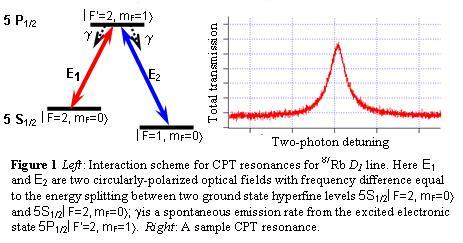|
Coherent Population Trapping
Coherent Population Trapping (CPT) is a particular case of
Electromagnetically Induced Transparency,
which occurs when two resonant optical fields interacts with
atoms in a L configuration, shown in Fig. 1.

In the case of alkali-metal atoms, each of two optical fields resonantly couples
one of the hyperfine levels of the S1/2 electronic ground state with
one hyperfine level of the P-state, as shown in Fig.1 for 87Rb atoms.
Normally, if the laser frequency is close to an optical transition, some or all of
the incoming light is absorbed and later dissipated in a form of incoherent spontaneous
emissions. However, if the frequency difference between the two applied optical fields
(E1 and E2 in Fig.1) exactly matches the microwave
transition frequency (two-photon resonance), then the atoms are placed in a quantum
superposition of two hyperfine states, the so called "dark state", which is completely
decoupled from both optical fields (i.e. atoms do not "see" or absorb any light).
This is the essence of Coherent Population Trapping, since atoms are effectively "trapped"
in the dark state and never promoted into the excited P-state. For example, for an ideal
three-level system shown in Fig.1, a dark state |D> is

Notice that the dark state is a coherent superposition of the dark states, since it is sensitive to the relative phase between two hyperfine statesí wave-functions. Perfect dark states exist only for exact two-photon resonance conditions. Hence the total transmission of atomic vapor is maximum at the two-photon resonance and decreases as the frequency difference between two laser fields deviates from the clock transition frequency. In the case of the frequency mismatch (two-photon detuning) relative phase between two hyperfine state wave-functions is accumulated, removing atoms from the dark state. As a result, total light transmission through the cell decreases. A sample CPT resonance (total light transmission as a function of two-photon detuning) is shown in Fig.1. The width of this peak is determined by the intensity of the laser fields and/or the lifetime of atoms in the dark state (decoherence time). In a vapor cell, the main source of decoherence is the collisions of atoms with cellís glass walls, which randomize phases of atomic states. The lifetime of the dark state is proportional to the time it takes an atom to traverse the interaction region. A common way of prolonging the interaction is to allow the alkali-metal atoms to diffuse in the atmosphere of an inert buffer gas, such as neon or helium, since collisions with the buffer gas atoms only weakly disturb the dark state.
|

